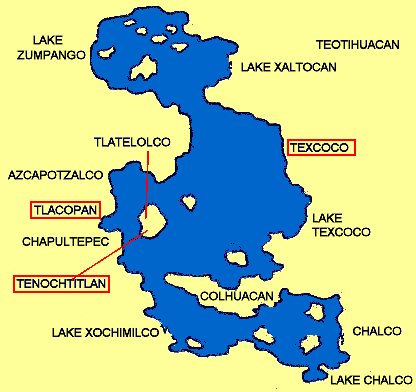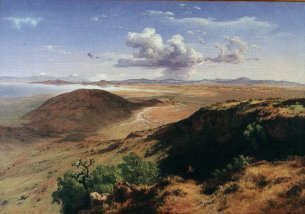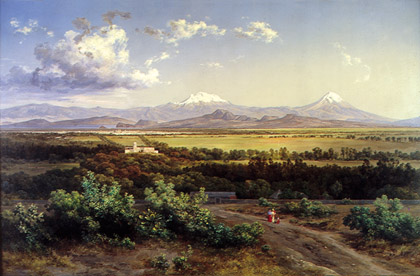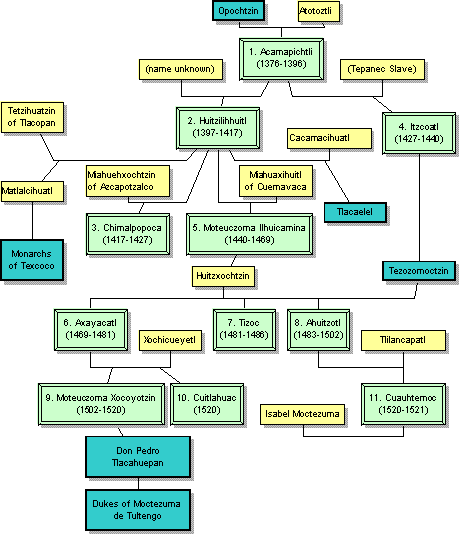(Nobody is sure where Chicomoztoc was. La Jolla has seven caves, but it is doubtful that the Mexica came from La Jolla. After all, if they had done that, they would have taken my class and would have known what would happen if they continued to do what they were doing.)
Legendary Toltec king Quetzalcoatl flees in 1168.
(Quetzalcoatl is also the name of a widely worshipped central Mexican god, after whom the Toltec king was presumably named, but the legends of the king and the god tend to be closely intermingled.
Toltec out-migration results (among other things) in foundation of Cholollan (modern Cholula) in central Mexico & Chichén Itzá in Yucatán.
Critical Background:
The two dominant towns among the successor states are:
| Town | People | Location |
|---|---|---|
| Azcapotzalco | Tepanecs | W of Lake Texcoco |
| Colhuacan
(modern Culhuacan) | Colhua | SE of Lake Texcoco |
Both towns boast "Neo-Toltec"dynasties, that is, their rulers claim to be descended from Toltec "nobility" and claim to be entitled to re-establish the old Toltec hegemony. Like the Mexica, the others are also Nahuatl speakers. Also like the Mexica, they each aspire to become the new rulers of the universe. Unlike the Mexica, they do not see much reason why the Mexica should have a piece of the action.
(The Otomí are sufficiently fierce warriors that the Mexica later will use this term to refer to the most violent of their own forces. Otomí arrival in the area makes everybody nervous.)
As they are driven out of Chapoltepec, the Mexica capture Copil, cut out his heart, and cast it into the lake. (Whoever does this does it with remarkable zest; it lands, according to tradition, some miles away on the island that will eventually become the center of the Aztec capital Tenochtitlan.)
The Mexica propose to make common cause against the Tepanecs with Coxcoxtli, a leader of the Tepanec-hating town of Colhuacan on the southeastern shore of Lake Texcoco, and receive permission to settle at a miserable snake-field called Tizaapan ("Place of White Water"), 10 km west of Colhuacan itself. (He apparently hopes that the dangerously violent Mexica will be done in by the snakes.)
In a moment of spectacular bad judgement, the Mexica sacrifice a Colhua princess intended for marriage and invite the king, her father, to celebrate the "wedding," where he sees a priest dancing around in her skin. The Colhua decide that enough is enough and attack the Mexica.
They flee to marshes and a small island at Acatzintlan, where they see an eagle perched on a cactus, the divine sign of their ultimate home.
Since they now facing hostility from Colhuacan, the Mexica place themselves back under the nominal protection of the Tepanecs, who are always eager to do whatever will annoy the Colhua.
Chinampas are fields made in swamps by piling up dirt from the bottom, in effect creating a world of dredged canals and artificial islands. (Click here for More About Chinampas. ) The heart of Tenochtitlan is at the present "Zócalo" (a.k.a. "Plaza de la Constitución") in the heart of Mexico City.
(The island is probably not completely without prior inhabitants, but there is no evidence of it being heavily populated before 1358.) There is never much differentiation between the two towns, and the constant expansion of made land on both soon unites them into what is, in effect, one continuous urban entity occupying a single artificial island. However from 1358 until 1473, Tlatelolco has separate and parallel institutions. In time Tlatelolco becomes Mexico's biggest market center.
Tradition records that the Mexica have been led by a mysterious figure named Tenochtli, who apparently died in 1372.
- In a process we can only imagine, Mexica leaders decide to form a Neo-Toltec pseudo-monarchy, choosing for this purpose Acamapichtli, whose father is a trustworthy Mexica leader, but whose mother is the daughter of the Neo-Toltec Colhua leader.
- Acamapichtli, while claiming this "Toltec blood," takes a wife from each of the Mexicacalpolli (usually interpreted as "clans"), creating the beginnings of a cross-clan "Toltec" nobility. (His first wife, Ilancuetl, is also a Colhua noble; she has no children, but strengthens the Toltec claim.)
- The title given is "tlahtoani" or "spokesman," and the office was always technically elective, despite its totalitarian power. The title is a nod to earlier traditions of the Mexica being governed by the consent of the calpolli elders, who remain powerful under the new scheme, since war booty left over after what is paid to the Tepanecs, is divided among calpolli (an arrangement which will later be changed).
- At the same time, in the second Mexica town of Tlatelolco, Cuacuapitzhuac is chosen as monarch, the son of Tezozomoc, the Tepanec leader of Azcapotzalco. There is thus a marriage alliance with each of the dominant towns, and each of the Mexica towns can claim to have a "Toltec" royal house.
She was a princess of the minor town of Tacoba, and her death provides a convenient opportunity for a match with a daughter of the aging Tezozomoc of the powerful city of Azcapotzalco.
The kid must be really cute, since Tezozomoc immediately begins to get soft on Mexica, worrying his advisers. (This kid's winning smile may have led to the ultimate destruction of Azcapotzalco and the triumph of the dreaded Mexica.)
This death allows Huitzilihhuitl to wed Miahuaxihuitl, a princess from Cuauhnahuac (modern Cuernavaca), a city to the south of the Valley of Mexico occupied by Nahuatl speakers referred to as the Tlahuica. The Tlahuica, like everybody else, have no use for powerful imperialists in the Valley of Mexico, and probably see an alliance with the scrappy but minor Mexica as useful against the Tepanecs and the Colhua.
Ixtlilxochitl is killed and succeeded by his son Nezahualcoyotl (1402-1472) (today famed as a major Nahuatl poet), who is forced to bide his time in exile plotting to retake Texcoco. Nezahualcoyotl's mother was from the newly created Mexica nobility, and he had some sympathy to Mexica views, especially to their hostility to Azcapotzalco.
(Some say Maxtla comes to power by murdering his older brother Tayauh, whom he regards as soft on Mexica.)
(Some whisper that the death of Chimalpopoca was set up by his uncle Itzcoatl, who thought he was too subsurvient to the Tepanecs.)
His second-in-command, a sort of Grand Vizier, bears the odd title Cihuacoatl, or Woman-Snake, although the office is held by a man.
The only bearer of the "Woman-Snake" title who matters to history is the long-lived Tlacaelel, the nephew of tlahtoani #4 Itzcoatl, and adviser to four tlahtoanis. Tlacaelel seems to be a cold-hearted but brilliant and utterly pragmatic strategist.
- At his suggestion, tlahtoani Itzcoatl distributes war booty to warriors, not calpolli leaders, with the result that power moves to ruler as calpolli leaders lose power to distribute prestitious resources. This is a major change in the structure of Mexica society as it moves more completely toward monolithic totalitarianism.
- Also at his suggestion, we are told in post-Conquest sources, all historical records (whatever they may have consisted of) were destroyed and replaced with falsified accounts designed to make the Mexica look legitimate, even glorious.
- Tlacaelel also seems to be the inventor of "flowery wars," conducted against friendly states with no miliary objective whatsoever, but with the "religious" goal of capturing thousands of young men to be sacrificed in ever larger rituals in honor of Huitzilopochtli as the patron of the régime.
- He is complicit, possibly central, in the enormous expansion, toward the end of his life, of sumptuary laws, the legal restrictions designed to confine luxury goods and special privileges to particular politically defined categories of people.
It is ironic that this cold-blooded combination of Machiavelli and Göbels is honored today as one of the architects of Mexican civilization.
Nobody gets to lay seige to Tenochtitlan. Tlahtoani #4 Itzcoatl receives assistance from Texcoco (under Nezahualcoyotl), plus towns originally settled by Tepanecs and therefore long allied with Azcapotzalco, but apparently oppressed by the fanatical Maxtla and his dynasty. The most important of these "Post-Tepanec" towns is Tlacopan (modern Tacuba) under Totoquihuatzin. Others are Huexotzingo (modern Cholula in the state of Puebla, a shrine center in much earlier centuries) and Tlaxcala. Tlacopan is destined to become the long-term ally of the Mexica, Tlaxcala their long-term enemy. All of these peoples are Nahuatl speakers, despite the tendency to refer to them by "ethnic" labels.
The allies at last succeed. Nezahualcoyotl is given the "pleasure" of cutting out Maxtla's heart and scattering his blood. It is clear that the alliance structure is the route to domination of surrounding polities.
| Town | Leader |
|---|---|
| Tenochtitlan
(& Tlatelolco) |
tlahtoani (ruler) Itzcoatl
(+ "Woman-Snake" Tlacaelel) |
| Texcoco | Nezahualcoyotl |
|
Tlacopan
(modern Tacuba) |
Totoquihua |

|
|
|
The various parts of Lake Texcoco have different names, from Lake Zumpango in the north to Lake Chalco in the South.
Map modified from Ciencias Sociales: Tercer Grado Consejo Nacional de Fomento Educativo, Mexico City, 1975, page 131. | |
Whatever the term "alliance" implies, this is never an group of equals. Tenochtitlan (and with it the other Mexica town of Tlatelolco) was always the dominant player, and Tlacopan was always the weakest.
Locusts, drought, floods, snowfall, early frosts and the human responses to all of these produce widespread starvation, emigration, sale of children, and other effects. Tlacaelel advocates massive human sacrifice as the solution. His advice is followed.
Mexica strategy shifts towards conquering areas outside the ecosystem of the Valley of Mexico that did not suffer from the same natural disasters.The principal accomplishments persuant to this policy were:
- Conquest of Coixtlahuaca & Veracruz (1458)
- Conquest of Coixlahuaca, a Mixtec town in the modern state of Oaxaca and possible stepping-stone to further conquests in Mixtec territory. (The Mixtec did not speak Nahuatl.)
- Conquest of Cempoala (on the Gulf Coast) in the territory of the Totonacs, another non-Nahuatl-speaking group.
- Conquest of the Huastecs on the Gulf coast north of the Totonacs
- Conquest of Chalco (1465)
- Conquest of the Tepeaca, south of Tlaxcala (an enemy state near Tenochtitlan that was never conquered)
Moquihuix, ruler of Tlatelolco, is married to tlahtoani #6 Axayacatl's sister and apparently has abused her, providing a pretext for direct control from Tenochtitlan. Tlatelolco is never again independent, but is instead ruled by a military governor.
- Vast expansion of the great temple of Tenochtitlan
- Second aqueduct to Tenochtitlan is built.
- Further expansion of massive human sacrifice.
- New war technique is introduced against Xiquipilco, Chiapa, and Xilotepec: total destruction of the population and replacement by Mexica immmigrants. (The adults are killed immediately or in a few cases saved to be sacrificed. Children are taken as slaves or sacrifical victims.)
Teloloapan, SW of Tenochtitlan, does not send representatives so all its inhabitants are immediately destroyed.
The same happens in Oztoma and Alahuiztla.
Oztoma, on the edge of Tarascan territory is heavily fortified in fear of a future assault.
Meanwhile, first European colonists arrive in Haiti
Meanwhile, Amerigo Vespucci discovers that America is not part of Asia
(Cf.: Paris 300,000, London 50,000, Seville 65,000)
He allies himself himself with Huastec and Totonac populations in that region, and eventually with the Nahuatl-speaking but non-Mexica city of Tlaxcala, the beleaguered but never conquered enemy of the Tenochtitlan régime. These alliances rapidly multiply into a general rebellion against Mexica hegemony. (Western accounts tend to portray events as the conquest of Mexico by the Spanish. Native accounts tend to represent the Spanish as convenient tools suddenly available to help overthrow oppressive enemies.)
He lives till 1425, so some sources end his reign then.
Most other areas are conquered within about a year. Many place names are shifted to Nahuatl, the lingua franca, or changed to Spanish, often using the names of saints.
Probably due to the inability of some viruses to be sustained during Ice Age migrations across Beringia —details— American populations had little resistance to imported cholera, smallpox, measels, typhus, or other Afroeurasian diseases.



